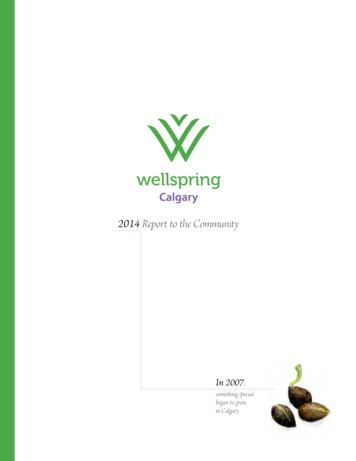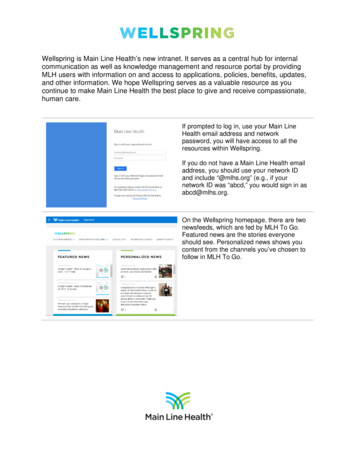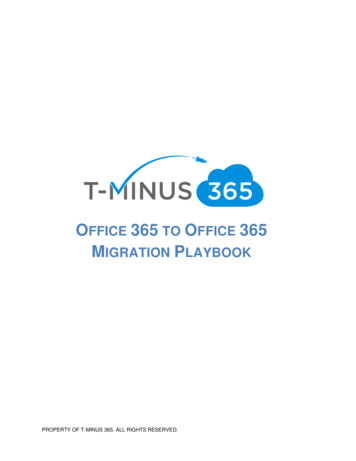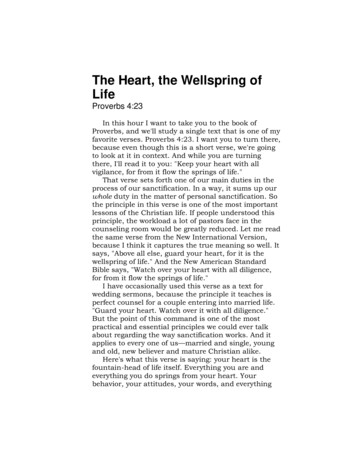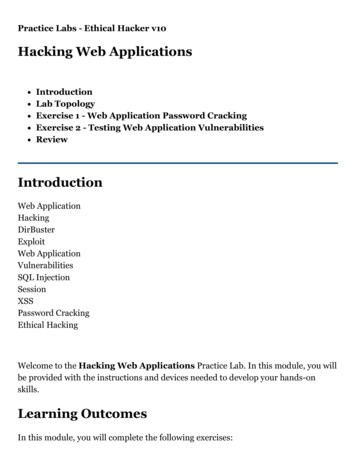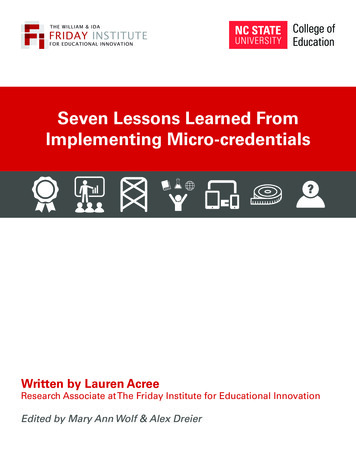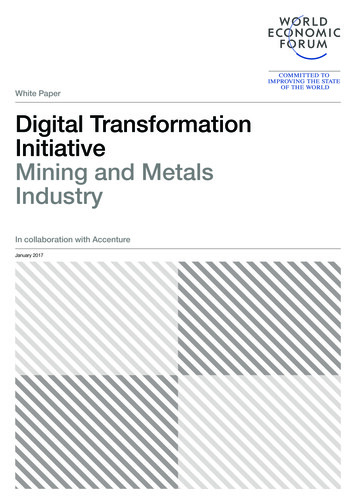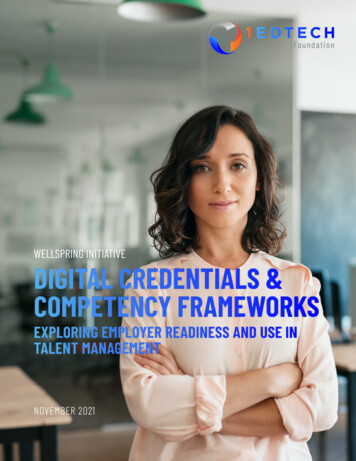
Transcription
WELLSPRING INITIATIVEDIGITAL CREDENTIALS &COMPETENCY FRAMEWORKSEXPLORING EMPLOYER READINESS AND USE INTALENT MANAGEMENTNOVEMBER 2021
1EDTECH FOUNDATIONWellspring InitiativePHASE II EMPLOYER READINESS SURVEY & REPORTPREFACEThis report summarizes recent research on the application of digital credentials to education and employmentfunded by the 1EdTech Foundation as part of the Wellspring Initiative.1EdTech Foundation is a non-pro t 501c3 organization that seeks to accelerate technology ecosystems to improvethe effectiveness of educational systems worldwide. 1EdTech Foundation works in concert with the af liated nonpro t IMS Global Learning Consortium, the world’s largest and most dynamic educational technology collaborative,consisting of over 675 organizations worldwide and other implementation partners.Wellspring is an ambitious multi-year initiative working on rewiring connections between individuals andopportunities for a better tomorrow. The goal is to develop a more effective education-to-employment-to-lifelonglearning ecosystem. The project facilitates collaboration among organizations, including employers, institutions, andtechnology providers, leading the way in deploying various parts of the ecosystem. The expectation is to enabledeployment and broad adoption of a new generation of digital achievement records, resumes, applicant trackingsystems, and talent management systems.This report focuses on understanding how corporate hiring and talent development processes will accept digitalcredentials developments on the mid-term horizon. Wellspring expects to conduct additional research along theselines as various technology components required to enable better connections are developed and deployed.We invite those interested in this work to join our collaboration!Rob Abel, Ed.D.President of 1EdTech FoundationCEO of IMS Global Learning Consortium1EdTech Foundation acknowledges the generous nancial support for this work from theCharles Koch Foundation and the Walmart Foundation.fi2fififiWELLSPRING PHASE II EMPLOYER READINESS RESEARCH
1EDTECH FOUNDATIONINTRODUCTIONOver the last decade, digital credentialing has become a major global trend in education and workforcedevelopment. Educational institutions have been developing and issuing shorter-form credentials in response to jobmarket demands. New types of professional education providers and even employers have begun to issuecredentials. In addition, traditional, static, paper-based credentials such as college diplomas are becoming moredigital, shareable, and veri able. The COVID-19 pandemic accelerated these existing trends, which sped up theadoption of online technology as an educational delivery mechanism—and the digitization of recruiting and hiringprocesses in the job market.As colleges and universities, professional associations, educational technology rms, and other parties who areeither credential issuers or enablers seek to grow and improve their offerings, the crucial employer demand side ofthe equation is still underexplored. There are plenty of news headlines about exciting new cloud-based HRtechnology systems, the promise of new types of credentials disrupting degrees, and employers adopting skillsbased hiring practices – but very little in the way of basic quantitative measures and the state of the landscape atthis intersection of education and talent.This survey report is an outgrowth of the 1EdTech Foundation and IMS Global Learning Consortium's WellspringInitiative, which aims to bring together institutions and corporations to accelerate an education-to-work ecosystem.Wellspring's work is based on the use of open standards for veri able digital credentials that capture learningachievements and skills to empower individuals to nd jobs and help transform the education system as it movesfrom valuing seat-time to skills. In several areas, this survey also builds on and extends Northeastern University'sprevious, rst-of-its-kind national survey on employers' use of educational credentials in hiring and relatedinnovations.1Given the rapid development and still early state of the digital credentialing ecosystem, the goal of this survey is toprovide market intelligence on employers' interest and readiness with respect to digital credentialing and the use ofcompetency frameworks by exploring priorities, strategies, and practices within employers' talent function. Thesurvey results that follow can help guide the development of future strategies and resources to address gaps indigital credentialing awareness and value perception, an important foundation for the growth of a more robustdigital credential market. Employers themselves, educational providers, technology platform companies, standardsorganizations, and many other interested parties can bene t from the data and benchmarks highlighted in thefollowing analysis.Sean R. Gallagher, Educational Credentials Come of Age: A Survey on the Use and Value of Educational Credentials in Hiring, 2018, 21/03/Educational Credentials Come of Age 2018.pdf; Northeastern University, Facing theFuture, June 2019, rn Gallup AI 2019.pdf1fififi3fififiWELLSPRING PHASE II EMPLOYER READINESS RESEARCH
1EDTECH FOUNDATIONAbout the Survey SampleThis survey of 750 HR leaders was designed by Northeastern University researchers and IMS staff andadministered online in partnership with market research rm Dynata in May 2021 to its nationally representativepanel of U.S. business decision-makers. Respondents were quali ed as managers in the HR function with primaryresponsibility or nal decision-making authority for hiring, recruiting, and talent strategy. The sample is generallyrepresentative of the U.S. economy as a whole, across a full range of industry sectors and organizational sizes. Fulldetails of the sample are provided in the Appendix.KEY TAKEAWAYS Technology tools are playing a growing role in hiring—including creating and managing job descriptions—and in the adoption of skill and competency frameworks. 75% of HR leaders report that they have sometype of technology system or bank of competencies and roles to use when creating job descriptions, andabout half the time, these are integrated with external systems. Skill or competency frameworks that consistently de ne the knowledge, skills, and abilities for roles arecommonly used for hiring, assessing candidates or employees’ current knowledge and skills, and staf ngand resource planning. How often these frameworks are updated is highly variable, ranging from every fewyears in most cases to a small share of employers who are updating these frameworks continuously.Respondents also report being open to the use and potential bene ts of industry-led external competencyframeworks, with 69% agreeing that these could be bene cial in creating a more uid market for talent intheir industry. A majority of organizations (73%) reported having some level of dedicated talent analytics effortsunderway, ranging from modest strategies and resourcing to powerful predictive analytics with dedicatedteams and technology, re ecting the growing availability of people analytics technology tools and thematuration of this emerging area within HR organizations. 34% of HR leaders indicated that their organization is operating with a skills-based hiring strategy thatfocuses more on competency in hiring rather than over-relying on college degrees: this is an increase from23% in a similar survey question three years ago. An additional 42% of respondents say that theirorganization is exploring and considering these approaches. The top motivations for skills-based hiring include more rigorous and better hiring outcomes (66%) anddiversity, equity, and inclusion (62%). The most common skills-based hiring approaches include pre-hiretesting/assessment (67%) and emphasizing structured interviewing (58%), among other approaches. The educational credentials presented by candidates in the hiring process are often but not always veri ed:respondents see value in means that would make educational credentials more veri able and trusted.When asked to characterize the utility of traditional college transcripts, only 44% of HR leaders consideredthem very or extremely useful.fifififlfifififi4fiflfiWELLSPRING PHASE II EMPLOYER READINESS RESEARCH
1EDTECH FOUNDATION Awareness and experience with digital badges appear to have grown modestly, with 87% of HR leadersreporting that they have at least heard of digital badges, up from 78% in a similar survey three years ago—including 48% who have encountered badges in screening candidates or hired a badge holder. Still, thereremains an opportunity and need to grow familiarity and awareness with new types of digital credentialsas half of all respondents either say they “don’t know much about” digital badges or have never heard ofthem. Many of the value propositions and use cases associated with digital credentials in hiring and L&D appearto resonate with HR leaders. These include, for example, the potential to more accurately measure skillsand specialized knowledge, providing evidence of mastery and documentation of learning. However, sincemany are not experienced with digital credentials, these value propositions and bene ts are prospectivemore than already achieved. Across various survey responses, HR leaders suggested an interest in the potential of newer, more digitalapproaches to improve hiring, skill assessment, training, and credentialing. When indicating the topbarriers within their organization that might pose a challenge to adoption, the top results were technicalintegration with other HR systems, lack of budget or time, and the challenges associated with including alltalent channels or coordinating with colleges and universities.Context: Talent Strategy Priorities and the State of Technology SystemsFirst, it is helpful to establish a sense of HR leaders’ talent strategy priorities, as this is the broader context withinwhich the use of educational credentials and learning records exists. Notably, in a very tight labor market today,talent strategy has risen to the top of C-suite agendas.2Respondents indicated that training and upskilling (86%), compliance (83%), and recruiting and hiring newemployees (81%) are their foremost priorities, based on rating these activities either “very” or “extremely”important. These were closely followed by workforce planning (77%), increasing workforce diversity, equity, andinclusion (75%), and automating talent strategy processes and practices (64%).As another important piece of context, the survey sought to establish the general state of organizations’ HR andtalent acquisition technology systems, e.g., applicant tracking, ERP, and human resource information systems. Thisprovides a contextual baseline for understanding organizations’ readiness for digital credentialing since thecapabilities and limitations of these systems often in uence or enable the adoption of new practices.In a check-all-that-apply question, more than one-third of respondents (39%) said that their systems “areeffectively integrated with each other,” and 32% of respondents characterized their systems as “cloud-based.” Only33% considered their systems “a strategic advantage.” Encouragingly, only 27% of respondents indicated that“accessing the right data is a challenge,” and just 17% said that their systems “are often a barrier.” Overall, thissuggests a very mixed picture relative to a potential ideal in which these systems—as a general category—arestrategic assets, but is consistent with expectations. As explored more later in this report, around half oforganizations are technologically very well-prepared for adopting approaches that this survey explored.Likewise, nearly half of all respondents (49%) reported that they plan to make major upgrades to their systems inthe future.22021 Fortune/Deloitte CEO Survey, ive-of cer/articles/ceo-survey.htmlfifi5flWELLSPRING PHASE II EMPLOYER READINESS RESEARCH
1EDTECH FOUNDATIONJob Descriptions and Competency FrameworksThe design and administration of job descriptions is a key aspect of talent management and matching candidatesto jobs. How job roles are codi ed and articulated closely links organizations’ potential adoption of competencyframeworks and new approaches to educational credentialing and skill assessment.Perhaps not surprisingly, most HR leaders report that creating and managing job descriptions within theirorganization is centralized—and characterize the process as rigorous and standardized.How would you describe how the creation and management of job descriptions ishandled within your tralized Centralized Decentralized Decentralized haphazard, inconsistent rigorous, standardized haphazard, inconsistent rigorous, standardized5%None of the aboveFIGURE 1.fiWELLSPRING PHASE II EMPLOYER READINESS RESEARCH6
1EDTECH FOUNDATION75% of respondents report having some type of bank of roles and competencies in a technology system that theycan draw on when creating a new position description. Of course, this could be as simple as an online le folder orjob library. Of those who do have a system, half (51%) say that it is integrated with outside third-party systemsand job posting boards, suggesting that in many cases, external systems and standards potentially have theopportunity to shape the framing of an employer’s speci c job roles.3Many in the HR eld have recognized that job descriptions can be burdensome to keep up-to-date—and that thisis increasingly the case in a world where skills requirements and evolving so quickly.4 The dynamic nature of jobssets the stage for the related use of skill or competency frameworks.Skill and Competency FrameworksSkill or competency frameworks are formalized models that de ne the knowledge, skills, and abilities associatedwith success in various job roles and business functions.The vast majority (85%) of surveyed HR leaders report that they use skill or competency frameworks for at leastsome roles within their organization, as indicated in Figure 2.Does your organization use skill or competency frameworks—that is, a formalized modelthat consistently de nes the knowledge, skills, and abilities for a given role?60%52%53%45%38%33%30%22%13%15%8%3%0%Yes, for most rolesYes, for some rolesNoNot sure/don't knowFIGURE 2.In a separate survey question, 73% of respondents agreed or strongly agreed that “LinkedIn and other networks/job boards have a growingimpact on the talent discovery process.”3Josh Bersin, “From Talent Management to Talent Experience. Why The HR Tech Market Is In Disruption,” JoshBersin.com, April 29, eign/4fifi7fififiWELLSPRING PHASE II EMPLOYER READINESS RESEARCH
1EDTECH FOUNDATIONThe most common activities that these frameworks are used for include hiring (74%), assessing candidates/employees’ current knowledge and skills (64%), staf ng/resourcing planning (63%), and identifying learning anddevelopment opportunities (54%).Interestingly, how often these frameworks are updated varies widely. As Figure 3 illustrates, half of therespondents report updating their frameworks every few years, while another 43% say they are updated either afew times a year (26%) or continuously (17%).How often are the skill or competency frameworks er or rarely3%Every 3-5 yearsEvery 1-3 yearsA few times per yearContinuously /in real-timeNot sure/don't knowFIGURE 3.These responses, when taken together, suggest that the typical skill/competency framework is refreshed aboutonce every 18 months.Given the constantly evolving nature of skills, in certain cases, employers have the opportunity to bene t fromindustry bodies and professional associations that are developing various frameworks that de ne skills-relatedstandards for industry sectors and occupations. However, there has been an open question about individualemployers’ receptivity to or ability to apply these external frameworks to their jobs.A substantial majority—69%—agreed that these types of resources could be bene cial in creating a more uidmarket for talent in their industry, and 72% agreed that industry frameworks could be useful in aligning the outputsof education and training programs with their needs. However, 41% of respondents felt that these types offrameworks would be dif cult to implement because they don’t account for their speci c job roles. Only onequarter (24%) characterized these frameworks as “not especially useful.”flfifififi8fifiWELLSPRING PHASE II EMPLOYER READINESS RESEARCH
1EDTECH FOUNDATIONTalent Analytics and Skills-Based HiringAs in other areas of business, the HR function is undergoing a technology-driven transformation that includes thegrowing application of data and analytics to processes and decision-making.5 The application of analytics to talentstrategy is also a potential foundation for de-emphasizing the reliance on degrees in hiring and can be closelycoupled with the use of digital credentialing and competency frameworks.A majority of organizations (73%) reported having at least modest efforts in using data and analysis to shape HRand hiring decisions. Notably, 37% of respondents said they have “signi cant predictive analytics strategy withdedicated teams/technology.”Which of the following best characterizes the state of your organization's use of dataand analysis to shape HR and hiring decisions ("people/talent %None or very littleSome localized,reactive analytics andreporting effortsModest, dedicatedSigni cant predictiveNot sure/don't knowanalytics strategy andanalytics strategyeffortwith dedicated teams/technologyFIGURE 4.These responses appear to re ect the growing availability of talent analytics tools and the maturity of the practicewithin some HR organizations6, potentially creating a strategic foundation for a future in which HR and hiringdecisions are more data-driven and in uenced by algorithms. This is an area that could bene t from deeperexploration.Doug Bonderud, “Prioritizing People Analytics: 6 HR-Driven Data Trends for 2021,” ADP SPARK, -2021.aspx5Dave Zielinski, “People Analytics Software is Changing the HR Game,” HR Magazine, December 4, 2019, e-analytics-software.aspx6fi9fiflflfiWELLSPRING PHASE II EMPLOYER READINESS RESEARCH
1EDTECH FOUNDATIONSkills Based HiringOver the last few years, skills-based hiring practices that focus hiring decisions on competencies and capabilityover degrees and pedigree have become increasingly popular, attracting signi cant attention from businessleaders, government, and the media.7 However, there has been relatively little analysis of employers’ interest in anduse of these strategies or motivations. This skills-based hiring trend is also of special interest to colleges,universities, and other educational providers as it could diminish to the primacy of the degree as a hiringrequirement.Northeastern University's prior research surveying HR leaders in late 2018 found that at that time, 23% oforganizations said they had a formal skills-based hiring effort underway or were moving to put them in place—andthat a further 39% were exploring or considering this direction.8Some organizations are making a strategic commitment to skills-based hiring practicesby focusing on demonstrated competency, rather than over-relying on college degrees.Which of the following best describes the extent to which your organization has formalinitiatives like this in place, or is considering this %2%We're not doing this and are not likely toconsider in the futureWe're not doing this but might consider itin the futureWe're exploring andconsidering thisWe are alreadyoperating in this wayNot sure/don't knowFIGURE 5.Michael Brickman, “How the Federal Government Made Skills-Based Hiring a Reality,” SHRM, May 25, 2021, pages/blog-skills-hiring-brickman.aspx78Gallagher, Educational Credentials Come of Age, Ibid.10fiWELLSPRING PHASE II EMPLOYER READINESS RESEARCH
1EDTECH FOUNDATIONToday, it appears that the adoption of and interest in skills-based hiring practices has indeed grown. As shown inFigure 5, 34% of HR leaders reported that they are “already operating in this way” with respect to skills-basedhiring practices—while another 42% are exploring and considering it.9 Only 6% of respondents said that they’reunlikely to consider this type of approach.In a check-all-that-apply question, 76% of respondents exploring or already engaged in skills-based hiring wereasked about their motivations for this. As Figure 6 below indicates, the most popular motivations from theseselections include “more rigorous, better hiring outcomes” alongside “diversity, equity, and inclusion.” Theseresponses appear to con rm the interest in skills-based hiring as an approach that can potentially lead to betterhiring processes and decisions and in more equitable ways—a priority that rose to the top of many corporateagendas over 202010.What are the main motivations for your organization's consideration or use ofskills-based hiring practices?More rigorous,better hiring outcomes66%62%Diversity, equity, and inclusionLimited supply of degreed talent need to expand the pipeline39%Frustration with theproducts ofcolleges and universities29%Regulatory/EEOC concerns29%1%Other0%10%20%30%40%50%60%70%FIGURE 6.9Note: For clarity, some slight, intentional changes to language were made to this survey question between yearsJordan Bryan, “How 2020 Accelerated Conversations on Diversity, Equity and Inclusion,” Gartner Insights, February 3, 2021, d-inclusion/10fiWELLSPRING PHASE II EMPLOYER READINESS RESEARCH11
1EDTECH FOUNDATIONIn addition, the survey sought to explore which speci c approaches to skills-based hiring are being used orconsidered. Figure 7 below illustrates that the top approach is pre-hire testing/assessment (67%), followed bystructured interviewing (58%). These were followed approaches pursued by just over one-third of respondents:requesting more evidence or using portfolios (39%), prioritizing certi cations (39%), and relaxing or eliminatingcollege degree requirements (36%).Which of the following approaches to skills-based hiring is yourorganization using (or considering)?67%Pre-hire testing/assessmentEmphasizing structuredinterviewing58%Requesting more evidenceor using portfolios39%Prioritizing certi cations39%Relaxing or eliminatingcollege degree requirements36%Drawing on new pathways/partners(e.g., apprenticeships, bootcamps)31%0%9%18%26%35%44%52%61%70%FIGURE 7.To the extent that many of these practices are still emerging, they represent an exciting area for continuedmonitoring and deeper exploration.fi12fifiWELLSPRING PHASE II EMPLOYER READINESS RESEARCH
1EDTECH FOUNDATIONEducational Credentials and Academic TranscriptsThe survey also explored particular practices related to the role of educational credentials and associated academicrecords in hiring. A rst question here concerned whether organizations formally verify or con rm the educationalcredentials presented by candidates in the hiring/recruitment process. Not surprisingly, veri cation was common—but at times depended on the context, as indicated in Figure 8.As part of the recruitment and hiringprocess, does your organization formallyverify/con rm the educational credentials(e.g., degrees) presented by candidates?No, never7%Sometimes depending on the context37%Yes, always56%FIGURE 8.In a follow-up question, 50% of respondents indicated that this veri cation was done in-house; 20% reported thatcredential veri cation was outsourced, and 31% indicated a combination of the two.fifi13fifififiWELLSPRING PHASE II EMPLOYER READINESS RESEARCH
1EDTECH FOUNDATIONIn addition, 64% of HR leaders agreed "it would be valuable for candidates' learning/credential claims to bevalidated by the distributed ledger (e.g., blockchain)." A similar share (60%) agreed that "credentialmisrepresentation and fraud" are signi cant business problems. These ndings speak to the potential value ofeducational credentials that are more easily veri able and trusted.HR leaders also characterized the utility of traditional college and university transcripts in the hiring process. Only44% of respondents considered transcripts at least "very useful."How would you characterize the usefulness of college/university transcripts (academicrecords of courses, grades, etc.) in the hiring process?30%25%25%24%20%20%20%15%10%5%0%8%3%Not applicableNot at all usefulSomewhat usefulUsefulVery usefulExtremely usefulFIGURE 9.fi14fifiWELLSPRING PHASE II EMPLOYER READINESS RESEARCH
Digital Credentials: Growth in Digital Badge AwarenessAlthough digital credentials are still relatively new in the hiring landscape, the growth in recent years has beensigni cant. As with the steadily increasing awareness and acceptance of online degrees over the last few decades,HR leaders’ understanding of digital credentials grows as more individuals encounter and earn them.11 Digitalbadges are the most mature and widely-awarded type of microcredential—with 43 million Open Badges awardedto date, up signi cantly from 24 million in 2018.1287% of survey respondents report that they have heard of digital badges—up from 78% in a similar survey in2018. However, only 48% of respondents are well-acquainted with badges, having encountered them in screeningcandidates (33%) or hired someone who holds a badge (15%). Notably, this half of respondents who haveencountered or hired badge holders is up from 40% in 2018.What is your level of awareness or experience with "digitalbadges" (information-rich records of veri able achievements, oftencontaining evidence of competency, that are easily shared on the web orsocial media)?13%I have never heard of themI have heard of them,but don't know much about them35%I have encountered them inscreening or hiring candidates33%I have hired someone whoearned them15%3%Don't know/not sure0%5%10%15%20%25%30%35%40%FIGURE 10.Thus, the market appears split between about half of HR leaders who have encountered or used badges in hiring—and about half who say they are either unfamiliar with or do not know much about them. This appears to con rmthe expectation that familiarity with badges is growing steadily over time—but also re ects an opportunity and aneed for growing awareness or understanding among employers about these new types of credentials.11Gallagher, Educational Credentials Come of Age, Ibid.IMS Global Learning Consortium, Badge Count 2020 Findings, e-count-2020ndings/12fi15flfifiWELLSPRING PHASE II EMPLOYER READINESS RESEARCHfifi1EDTECH FOUNDATION
1EDTECH FOUNDATIONIn addition, organizations’ readiness to integrate digital credentials into their hiring processes and systems varies. Inseparate survey questions, about half (54%) of respondents agreed or strongly agreed that “our hiring systems areready to interpret data from digital credentials,”—while 51% agreed that “data-rich learning and achievementrecords would challenge our hiring systems and current processes.”Given the potential utility of digital credentials in hiring, and learning and development, the survey tested theresonance of various value propositions or associated use cases. These results are presented in Figure 11.How impactful do you believe digital credentials could be to hiringand L&D, along the following dimensions?Increasing the veri ability of credentials23%36%28%10%Gauging potential job performance/success21%Increasing diversity by focusing on knowledge, skills,and abilities rather than other attributes22%Allowing employees to develop their careerby documenting learning23%Providing evidence for mastery of acompetency or skill24%37%26%Indicating specialized knowledge and expertise23%38%27%11%28%10%0%10%Very %27%More accurately measure competency and skillsExtremely Impactful35%50%60%Somewhat Impactful70%80%3%3%5%11%2%11%2%2%3%90% 100%Not at All ImpactfulFIGURE 11.As the graphic illustrates, the value propositions associated with digital credentials generally appear to resonate forHR leaders, with well over half rating these as potentially “very” or “extremely” impactful. At the same time, theclustering of these responses together suggests a relatively minor distinction between many of them. The speci c,skills-oriented focus and evidence of competency potentially associated with digital credentials seem to appeal toemployers—and this was a clear theme in open-ended comments as well.16fifiWELLSPRING PHASE II EMPLOYER READINESS RESEARCH
1EDTECH FOUNDATIONAlthough hiring was the major—but not exclusive—focus of this survey, a related question explored the value ofdigital credentials and new technologies to document current employees’ learning and development, speci cally.Here the most valuable use cases clustered in a similar range and included: Supporting professional development plans for employees or demonstrating a culture of learning (64%) Documenting internal course/training completion for compliance (63%) Analyzing talent pools for available skills (62%)Notably, these activities are prominent in the existing cases of employers in the marketplace (outside of the survey)who have invested heavily in badging their workforce.
Wellspring is an ambitious multi-year initiative working on rewiring connections between individuals and opportunities for a better tomorrow. The goal is to develop a more effective education-to-employment-to-lifelong learning ecosystem. The project facilitates collaboration among organizations, including employers, institutions, and


